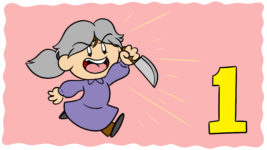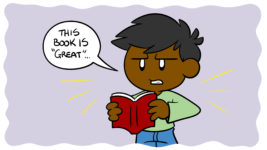In part 1 of this article (available here) we looked at some of the plot twists that only the bravest of authors should attempt in their writing – the type of high-risk, high-reward narrative developments that you need real guts to implement in your story.
We talked false protagonists, hidden identities, dishonest narrators, and the surprising rewards of the major time jump. Well, today we’re rounding out the list with two more entries and an honorable mention that might just work for you, beginning with…
5. The surprising spectacle
If you want to be an amazing writer, perhaps the most important thing to learn is when to let the reader do the work. There are moments – and they generally involve spectacle – where the thing you invite the reader to imagine is going to be scarier, funnier, or more amazing than anything you could actually write (not because you can’t write something scary/funny/amazing, but because you have to write something thousands can enjoy, while the reader only has to wow one person).
That’s a good rule to follow, but sometimes, actually showing this kind of spectacle constitutes a shockingly successful twist. In Patrick deWitt’s Undermajordomo Minor, the protagonist helps arrange a feast for his wealthy employer, knowing that the upper-class guests have a tradition of locking the doors and refusing to be disturbed for hours. The assumption is that something risqué will take place behind those locked doors, and usually this would be the kind of thing that’s best left to the reader’s imagination. In a lesser book, the protagonist would spy through the keyhole and the reader would infer what goes on from their reaction, adding whatever details titillate them most. Instead, deWitt shows it all, and it is… really something. It’s filthy, funny, debauched, and disturbing in all the ways the reader was expecting to be implied but never actually verified. It’s the rare moment that promises you something you can’t imagine and then absolutely delivers.
A less savory example comes from Martina Cole’s The Take. Now, I absolutely can’t recommend the horrifying rape scene Cole includes in her book (in fact, it’s the point at which I stopped reading), but I can say that in its specificity and directness, it elicits a sense of horror that trumps whatever would be conjured up by mere implication. Not something I want to read, but something that delivers on its writer’s intent in the same way as deWitt’s stranger and less distressing scene.
In both cases, the author promises an impossible level of engagement and then delivers. In such cases, the impact of the surprising spectacle is increased by the reader’s suspicion that the author wasn’t actually going to go there. It’s worth noting that there are two ways to approach this device – to build up a moment and then make sure you deliver, or to know that you have such a surprising spectacle that you can afford to seemingly oversell it. Both work, but if you know you have the latter, why not get a little more out of it?
Of course, if you’re going to bring this twist into your work, you really need to nail it. Promising the reader spectacle and then failing to deliver is far worse than having no spectacle at all, so unless you know you’re really going to knock their socks off, it’s better to show responses, consequences, hints around the edges – anything but a spectacle that can’t quite equal the reader’s personal efforts.
6. The unresolved ending
The riskiest of all risky plot twists is to leave things hanging – to refuse the reader the answer they’ve been hoping for, especially in cases where that answer will never be given.
This is something William Goldman does masterfully in The Princess Bride, ending the book by suggesting that while his heroes may be riding off into the sunset, that doesn’t mean they’ll actually escape. Likewise, Thomas Pynchon’s The Crying of Lot 49 ends right before the moment that would reveal whether its central mystery is a genuine conspiracy or just a cruel trick being played on the narrator.
Jasper Fforde’s Shades of Grey is a particularly notable example, as he actually takes back his satisfying ending – the protagonist can have what he wants, he’s managed to save some innocents, but he throws it all away for a chance at addressing a larger injustice.
The unresolved ending can really blow up in your face – many readers hate an incomplete ending – but it can also lodge your story in someone’s mind for a lifetime. Of course, it’s not just about withholding information. Anyone can invite frustration by refusing to finish their story, but inviting delight takes a deft touch.
In each of the cases above, the unresolved ending is satisfying partly because the plot isn’t concluded but the ideas behind the story have been satisfactorily explored. The Princess Bride is about the hero saving his beloved. Once she’s saved, what happens next is mostly academic – the reader knows that fairy tales always end happily ever after, even if what that means can vary. In The Crying of Lot 49, the plot may follow the conspiracy, but it’s about the emotional experience of searching for impossible answers. Shades of Grey is cheating a little, since a sequel was once intended (and, nine years later, hasn’t yet been canceled), but the story has been about the protagonist trying to escape the strictures of their society, it’s just that the way in which they do so invites further problems.
In each case, the concepts that the story trades in, the ideological question it promised to answer, are addressed. Love wins out, conspiracy erodes our confidence in reality, and class is an artificial way of consolidating power. These statements are made, the reader is given satisfaction, but then the author adds some extraneous factual details that create the sense that there’s more still to come. In its simplest form, this creates a feedback loop where the reader has to keep assuring themselves of what they know:
- Will the characters really be alright? Yes, because love wins out. But will they really be alright? Yes, because love wins out. But…
- Was it a real conspiracy? It doesn’t matter, because the suspicion alone is the trap. Yeah, but was it a real conspiracy? It doesn’t matter, because…
- Will we always be separated from other people? We don’t have to be, because that separation is artificial. Okay, but will we always…
In this way, the unresolved plot gives your reader just enough excuse to keep reviewing the satisfaction they got from your ideas. In his MasterClass lecture, R.L. Stine discusses using this device in horror, and how he always makes sure to have his characters resolve the threat but then discover that they’re being menaced by something similar but different. The puzzle of the story is solved, but the reader gets to keep feeling scared, which is the thing they wanted from their reading experience.
The unresolved ending is easily the riskiest twist on this list, and doing it successfully depends on understanding exactly what your story is about and the journey on which you’ve taken your reader.
Honorable mention: And it was all a dream…
A plot twist that doesn’t quite make this list, but which is worth discussing alongside it, is revealing that your story didn’t truly take place. Your character is dreaming, or they’re in the afterlife, or they’re imagining things, or they’re mentally ill, and the events of your story are tied together by the realization that they don’t have to make sense, because they didn’t really happen.
This plot twist is much maligned, and for a couple of reasons. The first is that it’s often misused. Wrapping things up by voiding the rules of reality is only satisfying if it feels earned – otherwise it comes across as a cheap way of ignoring anything that isn’t convenient to the ending you wanted to reach. The other is that it’s predictable – while the exact details may not be immediately apparent, any savvy reader already knows that ‘this isn’t really happening’ is a likely possibility in any slightly strange story, which means that when it’s revealed, it fails to come across as a charming surprise.
Books like Shutter Island make great use of turning a story on its head by revealing that most of the details weren’t accurate to reality, but if your reader sees that twist coming, they’re likely to grow bored or frustrated waiting for you to get around to admitting it. The television drama Lost suffered in public opinion when the mystery went on long enough that people just started assuming it was set in purgatory – in fact, even though that wasn’t the case, it remains a common misconception.
Despite these problems, the reveal that your setting is imaginary/the afterlife/a dream etc. can still be a great twist. Flann O’Brien’s The Third Policeman, Ambrose Bierce’s ‘An Occurrence at Owl Creek Bridge’, and Alice’s Adventures in Wonderland all use the reveal of their metaphysical settings to tell fascinating stories, so what’s the difference between success and failure?
Success seems to lie in using these settings not to dismiss unusual happenings, but rather to expand the significance of events. The use of purgatory in The Third Policeman doesn’t explain away the strange events of the story, it underlines their importance, since they’re what the protagonist needs to confront to move on. Likewise, the imaginary sections of ‘An Occurrence at Owl Creek Bridge’ aren’t just about setting up a less pleasant ending, they’re about making it clear what the protagonist truly desires in his final moments. The dream setting of Alice’s Adventures in Wonderland is, on the surface, an excuse for a lot of strange imagery, but the story has had such a lasting legacy not because dreams excuse any old happening, but because they imply a deeper level of truth.
In short, if the twist of your metaphysical setting is just that normal rules never applied or certain events can be ignored, the reader is likely to feel cheated, but if the twist is that the events of your story matter even more than they seemed – that their significance transcends the mundane world – then you’re much more likely to succeed.
Twists of fate
The twists above aren’t for every writer, and it’s rarely a good idea to craft a story just to justify a twist, but on those occasions where they’re appropriate, you’ll find they’re the perfect tool for the job. A time jump may be ideal for your story, and an unresolved ending may give it a whole new life, but you’ll only be able to draw on them at these times if you get comfortable with them in advance.
Experiment a little, think of your perfect version of each twist, write a story or two to get acquainted, and then on those occasions where one of the twists above is what you need, you’ll find it ready and waiting. What literary plot twists have inspired you, and how did they do it? Let me know in the comments, and check out The Secret Art Of Writing A Surprising Plot Twist and Here’s How To Write A Killer Climax That Leaves Readers Breathless for more on writing great plot twists.






1 thought on “6 Daring Plot Twists To Try In Your Writing – Part 2”
Hello, I have been writing multiple Murder Mysteries, and this was the most relevant post to my question. I have built up the six suspects, but I like them so much. They all represent a different type of Mystery Characters. I don’t even know which one did it. How should I narrow it down?